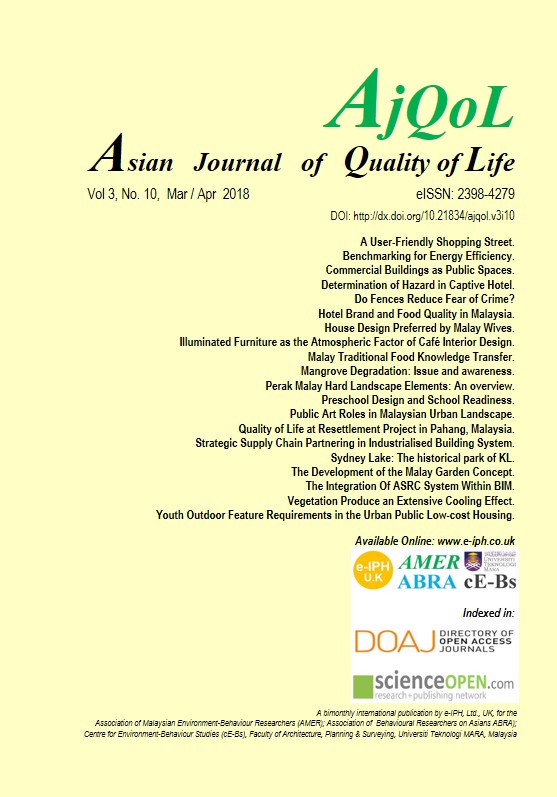Benchmarking for Energy Efficiency
Main Article Content
Abstract
Increased energy demand end to the world grew by 39% between 1990 to 2008 and further increased by 40% between 2007 to 2030. Energy consumption in buildings has been identified to contribute up to 40% of the total world. Through the selection of methods and the right strategy will reduce the problem of increase energy in buildings. Based on the theory of energy efficiency developed it can achieve through three main factors; a) building design; b) design of services; c) user behavior. This paper aims to discuss methods to benchmark user perception on energy efficiency in school buildings.
Metrics
Article Details
License
Copyright (c) 2018 Mohd Najib Mohd Salleh, Mohd Zin Kandar, Siti Rasidah Md Sakip

This work is licensed under a Creative Commons Attribution-NonCommercial-NoDerivatives 4.0 International License.
References
Al-Mofleh, A., Taib, S., Mujeebu, M. A., & Salah, W. (2009). Analysis of sectoral energy conservation in Malaysia. Energy, 34(6), 733–739. Retrieved from http://dx.doi.org/10.1016/j.energy.2008.10.005 DOI: https://doi.org/10.1016/j.energy.2008.10.005
Catalina, T., & Iordache, V. (2012). IEQ assessment on schools in the design stage. Building and Environment, 49(1), 129–140. Retrieved from http://dx.doi.org/10.1016/j.buildenv.2011.09.014 DOI: https://doi.org/10.1016/j.buildenv.2011.09.014
Chung, W. (2011). Review of building energy-use performance benchmarking methodologies. Applied Energy, 88(5), 1470–1479. http://doi.org/10.1016/j.apenergy.2010.11.022 DOI: https://doi.org/10.1016/j.apenergy.2010.11.022
de Vaus, D. A. (1986). Surveys In Social Research. London, Academic Divison Of Unwin Hyman Ltd.
de Vellis, R. F. (1991). Scale Development: Theory and Aplication. Thousand Oaks, CA, Sage.
EXXON Mobil. (2014). The outlook for energy: A view to 2040 Texas.
González, A. B. R., Díaz, J. J. V., Caamano, A. J., & Wilby, M. R. (2011). Towards a universal energy efficiency index for buildings. Energy and Buildings, 43(4), 980–987. DOI: https://doi.org/10.1016/j.enbuild.2010.12.023
Hoes, P., Hensen, J. L. M., Loomans, M. G. L. C., De Vries, B., & Bourgeois, D. (2009). User behavior in whole building simulation. Energy and Buildings, 41(3), 295–302. http://doi.org/10.1016/j.enbuild.2008.09.008 DOI: https://doi.org/10.1016/j.enbuild.2008.09.008
Ibrahim, K., M.Z. Kandar, & Y. Norashid. (2005). Koleksi pertandingan projek kecekapan tenaga diperbaharui (KT&DT) sekolah-sekolah menengah Se Malaysia 2003.
IMT Institute for Market Transformation. (2012). Promoting energy efficiency in buildings. Retrieved from http://www.imt.org/
Keazer, J. A. (2007). A Study Of Arkansas K-12 School Building Energy Requirements And An Evaluation Of Improvements Toward Energy Efficiency Using Building Energy Simulations. University Of Arkansas.
Khan, S., & Kotharkar, R. (2013). Methodological Approaches to Assessing Child Centricity in Urban Schools of India. Journal of ASIAN Behavioural Studies, 3, 79–94. DOI: https://doi.org/10.21834/jabs.v3i6.245
Kim, T. W., Lee, K. G., & Hong, W. H. (2012). Energy consumption characteristics of the elementary schools in South Korea. Energy and Buildings, 54, 480–489. http://doi.org/10.1016/j.enbuild.2012.07.015 DOI: https://doi.org/10.1016/j.enbuild.2012.07.015
Kubiszewski, I., Cleveland, C. J., Miller, M., & Saundry, P. (2012). United Nations Conference on Environment and Development (UNCED), Rio de Janeiro, Brazil. Retrieved April 14, 2016, from http://www.eoearth.org/view/article/156773/
Lee, W. L., Yik, F. W. H., & Burnett, J. (2003). A method to assess the energy performance of existing commercial complexes. Indoor and Built Environment, 12, 311–327. DOI: https://doi.org/10.1177/142032603035424
Masoso, O., & L. Grobler, L. (2010). The Dark Side Of Occupants’ Behavour On Building Energy Use. Energy and Buildings, 42, 173–177. DOI: https://doi.org/10.1016/j.enbuild.2009.08.009
Nunnally, J. C., & Bernstein, I. H. (1994). Psyhometric Theory. New York: Mcgraw-Hill.
Pallant J. (2005). Spss Survival Manual; A Step By Step Guide To Data Analysis Using Spss For Window. Sydney, Australia.
Paul, N. A. P., & Speer, P. W. (2008). Linking Organizational Characteristics to Psychological Empowerment: Contextual Issues in Empowerment Theory. Administration in Social Work, 3107(October 2014), 37–41.
Perez, Y. V., & Capeluto, I. G. (2009). Climatic considerations in school building design in the hot-humid climate for reducing energy consumption. Applied Energy, 86(3), 340–348. http://doi.org/10.1016/j.apenergy.2008.05.007 DOI: https://doi.org/10.1016/j.apenergy.2008.05.007
Piaw, C. Y. (2009). Kaedah dan Statistik Penyelidikan; Statistik Penyelidikan Lanjutan Ujian Regresi, Analisis Faktor dan Analisis SEM. McGraw Hill Education.
Programme, U. N. E. (2016). United Nations Environment Programme environment for development. Retrieved January 14, 2016, from http://www.unep.org/about/
R. Saidur. (2009). Energy consumption, energy savings, and emission analysis in Malaysian office buildings. Energy Policy, 37(10), 4104–4113. http://doi.org/10.1016/j.enpol.2009.04.052 DOI: https://doi.org/10.1016/j.enpol.2009.04.052
Rahman, A. M. A., Samad, M. H. A., Bahaudin, A., & Ismail, M. R. (2009). Towards A Low-Energy Building Design for Tropical Malaysia. Universiti Sains Malaysia.
Salleh, M. N. M. (2008). Reka Bentuk Sekolah Kebangsaan Daripada Aspek Kecekapan Tenaga: Kajian Kes Daerah Perak Tengah. Universiti Sains Malaysia.
Salleh, M. N. M. (2012). Gerakan baru Dalam Senibina Lestari: Buuh Sebagai Sumber Dan Bahan Binaan Untuk Bangunan Hijau. Habitat Magazine, 29.
Sanchez, Y. (2008). Cmgt-564 Catholic University of America. Retrieved from http://www.nahbgreen.org/About/greenhomebuilding.aspx
The IEA Website. (2010). The IEA Website. Retrieved from http://www.iea.org/
U.S. Environmental Protection Agency. (2011). Energy Efficiency Programs in K-12 Schools. Retrieved from http://www.epa.gov/statelocalclimate/documents/pdf/k-12_guide.pdf
US DOE-Energy Smart Schools. (2015). US Department of Energy Energy Efficiency and Renewable Energy, Building Technologies Program.
Wang, S., Yan, C., & Xiao, F. (2012). Quantitative energy performance assessment methods for existing buildings. Energy and Buildings, 55, 873–888. http://doi.org/10.1016/j.enbuild.2012.08.037 DOI: https://doi.org/10.1016/j.enbuild.2012.08.037
WBCSD. (2009). Energy efficiency in buildings-transforming the market.




